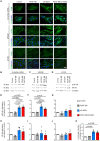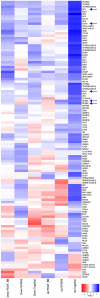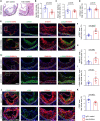Neutralization of S100A4 induces stabilization of atherosclerotic plaques: role of smooth muscle cells
- PMID: 33135065
- PMCID: PMC8752361
- DOI: 10.1093/cvr/cvaa311
Neutralization of S100A4 induces stabilization of atherosclerotic plaques: role of smooth muscle cells
Abstract
Aims: During atherosclerosis, smooth muscle cells (SMCs) accumulate in the intima where they switch from a contractile to a synthetic phenotype. From porcine coronary artery, we isolated spindle-shaped (S) SMCs exhibiting features of the contractile phenotype and rhomboid (R) SMCs typical of the synthetic phenotype. S100A4 was identified as a marker of R-SMCs in vitro and intimal SMCs, in pig and man. S100A4 exhibits intra- and extracellular functions. In this study, we investigated the role of extracellular S100A4 in SMC phenotypic transition.
Methods and results: S-SMCs were treated with oligomeric recombinant S100A4 (oS100A4), which induced nuclear factor (NF)-κB activation. Treatment of S-SMCs with oS100A4 in combination with platelet-derived growth factor (PDGF)-BB induced a complete SMC transition towards a pro-inflammatory R-phenotype associated with NF-κB activation, through toll-like receptor-4. RNA sequencing of cells treated with oS100A4/PDGF-BB revealed a strong up-regulation of pro-inflammatory genes and enrichment of transcription factor binding sites essential for SMC phenotypic transition. In a mouse model of established atherosclerosis, neutralization of extracellular S100A4 decreased area of atherosclerotic lesions, necrotic core, and CD68 expression and increased α-smooth muscle actin and smooth muscle myosin heavy chain expression.
Conclusion: We suggest that the neutralization of extracellular S100A4 promotes the stabilization of atherosclerotic plaques. Extracellular S100A4 could be a new target to influence the evolution of atherosclerotic plaques.
Keywords: ApoE−/−; CD68; Extracellular S100A4; NF-κB; RAGE; Smooth muscle myosin heavy chains; TLR4; α-Smooth muscle actin.
© The Author(s) 2020. Published by Oxford University Press on behalf of the European Society of Cardiology.
Figures








Comment in
-
Extracellular role of S100 calcium-binding protein A4 in atherosclerosis.Cardiovasc Res. 2022 Jan 7;118(1):1-3. doi: 10.1093/cvr/cvab166. Cardiovasc Res. 2022. PMID: 33964135 No abstract available.
-
c-Src regulatory role of NOX5 activation and hypertension: a new piece of the puzzle.Cardiovasc Res. 2022 Mar 25;118(5):1170-1172. doi: 10.1093/cvr/cvab265. Cardiovasc Res. 2022. PMID: 34352096 No abstract available.
Similar articles
-
Extracellular S100A4 induces smooth muscle cell phenotypic transition mediated by RAGE.Biochim Biophys Acta. 2015 Sep;1853(9):2144-57. doi: 10.1016/j.bbamcr.2014.07.022. Epub 2014 Aug 7. Biochim Biophys Acta. 2015. PMID: 25110349
-
Vitamin K2 can suppress the expression of Toll-like receptor 2 (TLR2) and TLR4, and inhibit calcification of aortic intima in ApoE-/- mice as well as smooth muscle cells.Vascular. 2018 Feb;26(1):18-26. doi: 10.1177/1708538117713395. Epub 2017 Jun 6. Vascular. 2018. PMID: 28587577
-
Intimal smooth muscle cells of porcine and human coronary artery express S100A4, a marker of the rhomboid phenotype in vitro.Circ Res. 2007 Apr 13;100(7):1055-62. doi: 10.1161/01.RES.0000262654.84810.6c. Epub 2007 Mar 8. Circ Res. 2007. PMID: 17347479
-
Smooth muscle cell fate and plasticity in atherosclerosis.Cardiovasc Res. 2018 Mar 15;114(4):540-550. doi: 10.1093/cvr/cvy022. Cardiovasc Res. 2018. PMID: 29385543 Free PMC article. Review.
-
Altered Smooth Muscle Cell Force Generation as a Driver of Thoracic Aortic Aneurysms and Dissections.Arterioscler Thromb Vasc Biol. 2017 Jan;37(1):26-34. doi: 10.1161/ATVBAHA.116.303229. Epub 2016 Nov 22. Arterioscler Thromb Vasc Biol. 2017. PMID: 27879251 Free PMC article. Review.
Cited by
-
Single cell transcriptomics and TCR reconstruction reveal CD4 T cell response to MHC-II-restricted APOB epitope in human cardiovascular disease.Nat Cardiovasc Res. 2022 May;1(5):462-475. doi: 10.1038/s44161-022-00063-3. Epub 2022 May 12. Nat Cardiovasc Res. 2022. PMID: 35990517 Free PMC article.
-
S100 proteins in cardiovascular diseases.Mol Med. 2023 May 22;29(1):68. doi: 10.1186/s10020-023-00662-1. Mol Med. 2023. PMID: 37217870 Free PMC article. Review.
-
S100A4 Is a Key Facilitator of Thoracic Aortic Dissection.Int J Biol Sci. 2024 Jan 1;20(1):29-46. doi: 10.7150/ijbs.83091. eCollection 2024. Int J Biol Sci. 2024. PMID: 38164183 Free PMC article.
-
Inhibition of S100A4 decreases neurotoxic astrocyte reactivity and attenuates neuropathic pain via the TLR4/NF-κB pathway in a rat model of spinal nerve ligation.J Headache Pain. 2025 May 1;26(1):97. doi: 10.1186/s10194-025-02045-9. J Headache Pain. 2025. PMID: 40312684 Free PMC article.
-
iTRAQ Proteomics Identified the Potential Biomarkers of Coronary Artery Lesion in Kawasaki Disease and In Vitro Studies Demonstrated That S100A4 Treatment Made HCAECs More Susceptible to Neutrophil Infiltration.Int J Mol Sci. 2022 Oct 23;23(21):12770. doi: 10.3390/ijms232112770. Int J Mol Sci. 2022. PMID: 36361563 Free PMC article.
References
-
- Basatemur GL, Jorgensen HF, Clarke MCH, Bennett MR, Mallat Z. Vascular smooth muscle cells in atherosclerosis. Nat Rev Cardiol 2019;16:727–744. - PubMed
-
- Allahverdian S, Chehroudi AC, McManus BM, Abraham T, Francis GA. Contribution of intimal smooth muscle cells to cholesterol accumulation and macrophage-like cells in human atherosclerosis. Circulation 2014;129:1551–1559. - PubMed
Publication types
MeSH terms
Substances
LinkOut - more resources
Full Text Sources
Medical
Molecular Biology Databases
Research Materials
Miscellaneous

